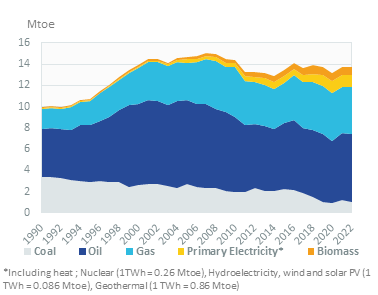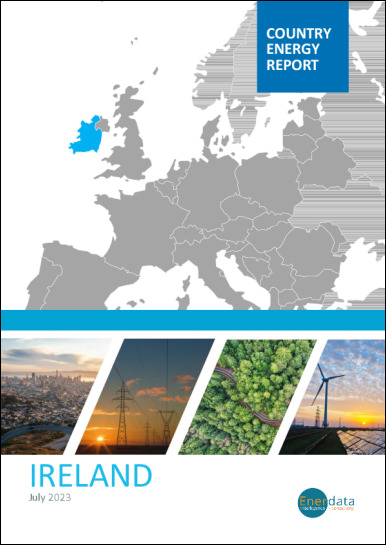- Update
-
- Format
- 4 files (PDF report, 3 Excel files)
- Pages
-
37 (Report only)
- Delivery
- Immediate by e-mail
- GENERAL OVERVIEW
- INSTITUTIONS AND ENERGY POLICY
- ENERGY SUPPLY
- ENERGY PRICES
- ENERGY CONSUMPTION
- ISSUES AND PROSPECTS
- DATA TABLES
- ABBREVIATIONS
- GLOSSARY
Buy Ireland energy report
Price without VAT. Depending on your statute and location, VAT might be applicable. Get in touch with us for more information.
After validation, you will immediately receive 4 files by email (one pdf report and 3 excel files containing the datasets).
Overview
This analysis includes a comprehensive Ireland energy market report and updated datasets. It is derived from the most recent key economic indicators, supply and demand factors, oil and gas pricing trends and major energy issues and developments surrounding the energy industry. The report provides a complete picture of the country situation, dynamics, current issues and future prospects. With market data and continuous follow-up of markets news, this report brings clear and concise insights with which to tackle national energy challenges and opportunities. Browse the tabs below for a detailed table of contents, the list of graphs and tables, and details on the data files.
Highlights
- The first carbon budget has been approved, setting an emission ceiling at 295 MtCO2eq over 2021-2025.
- ESB dominates the power sector, with half of the capacity,and ownership of transmission and distribution.
- Centrica leads the gas market with a share of 41% in 2022.
- BnM ended peat production in 2020 to focus on renewables.
- Gas imports have nearly doubled since 2018 to offset the closure of Kinsale in 2020.
- Natural gas represents half of the power mix, while wind is surging (+23 pp since 2010 to 33% in 2022).
- In order to address rising energy costs, the VAT rate on gas and electricity was cut to 9% until October 2023.
- Gas prices for industry surged by 40% in 2022.
- Total energy consumption has been stable since 2018, with a slight dip in 2020.
- The share of gas in the energy mix has increased by 4 pp since 2015, reaching 32% in 2022, while the share of coal and peat dropped by 8 pp to 8%.
- The 700 MW Celtic interconnector project between Ireland and France has been approved.
- In May 2023, Ireland awarded more than 3 GW of offshore wind across four projects in its first offshore wind auction (ORESS-1). The country now has 28 GW of wind capacity under development.
Institutions & Energy Policy
The Department of Communications, Climate Action, and Environment (DCCAE) is responsible for the country's overall energy policy, including energy security, and competitiveness, governance of public energy companies and sustainable energy policy.
Energy Supply
Oil:
There is currently no oil production. Providence Resources was the first company to report commercially viable oil flow from its Barryroe well in 2012.
Ireland imports all its crude oil and about 90% of its refined product needs. Ireland's oil dependency is among the highest in the EU.
Energy Prices
Gas:
The price of natural gas follows trends in the international markets. In 2022, gas prices for households increased by 24% to €9.2c/kWh. Industrial prices increased by 4.3%/year between 2016 and 2021, and surged by 41% in 2022 to €5.9c/kWh.
Graph: GAS PRICES FOR INDUSTRY AND HOUSEHOLDS (€c/kWh GCV)
Energy Consumption
In 2022, consumption per capita was 2.7 toe (down from 3.2 toe in 2010) and about 10% below the EU average. Per capita electricity consumption was almost 6000 kWh in 2022, slightly above the EU average.
Graph: CONSUMPTION TRENDS BY ENERGY SOURCE (Mtoe)

Issues & Prospects
Gas:
According to the Network Development Plan 2021 of Gas Networks Ireland, gas consumption is expected to increase by 15% between 2020-2021 and 2029-2030 in the median scenario.
- GRAPH 1: CO2-energy emissions (MtCO2)
- GRAPH 2: Installed electric capacity by source (2022, %)
- GRAPH 3: Gross power production by source (TWh)
- GRAPH 4: Power generation by source (2022, %)
- GRAPH 5: Gasoline & diesel prices (€/l)
- GRAPH 6: Electricity prices for industry and households (€c/kWh)
- GRAPH 7: Gas prices for industry and households (€c/kWh GCV)
- GRAPH 8: Consumption trends by energy source (Mtoe)
- GRAPH 9: Total consumption market share by energy (2022, %)
- GRAPH 10: Final consumption market share by sector (2022, %)
- GRAPH 11: Oil consumption (Mt)
- GRAPH 12: Oil consumption breakdown by sector (2022, %)
- GRAPH 13: Electricity consumption (TWh)
- GRAPH 14: Electricity consumption breakdown by sector (2022, %)
- GRAPH 15: Natural gas consumption (bcm)
- GRAPH 16: Gas consumption breakdown by sector (2022, %)
- GRAPH 17: Coal consumption (Mt)
- GRAPH 18: Coal consumption breakdown by sector (2022, %)
- Economic Indicators: Annual historical data including population, GDP growth, imports and exports, inflation rate, energy security and efficiency indicators, CO2 emissions.
- Supply Indicators: Historical data including oil and gas reserves, electric and refining capacity, energy production, power production and external trade. All are detailed by energy source.
- Demand Indicators: Historical data including consumption per inhabitant, consumption trends, total consumption by energy source, final consumption by energy source and sector, and electricity consumption by sector.
- Energy Balances: Single table displaying the overall energy industry balance per annum, also graphically displayed by energy sub-segment.
- Infrastructure Projects: Covers power plant projects by energy, technology, status and operator, gas plant projects by status and operator and LNG contracts.
The Ireland energy market data since 1990 and up to
is included in the Excel file accompanying the Ireland country report.
It showcases the historical evolution, allowing users to easily work with the data.
Key Data included in the excelsheet:
- Economic indicators: Annual historical economic indicators, energy security, energy efficiency and CO2 emissions.
- Supply indicators: Annual historical reserves, capacity, production and external trade (imports(+) exports(-) balance).
- Demand indicators: Annual historical consumption per capita, consumption trends, total consumption, final consumption (per energy and per sector) and electricity consumption total and per sector.
- Energy Balance: total and per energy.
- Ireland Energy Prices: In addition to the analysis provided on the report we also provided a data set which includes historical details on the Ireland energy prices for the follow items: price of premium gasoline (taxes incl.), price of diesel (taxes incl.), price of electricity in industry (taxes incl.), price of electricity for households (taxes incl.), price of natural gas in industry (taxes incl.), prices of natural gas for households (taxes incl.), spot price of Brent and CO2 emissions (from fuel combustion).
The Ireland country dashboards are complemented with country forecasts from EnerFuture (excel file) with scenario comparison.
Data included in the excelsheet:
- Demand: Primary energy consumption, final energy consumption, by fuel, by sector.
- Power: Electricity generation & capacities, by technology.
- CO2: Total CO2 emissions.
- Macro-economy: Main macro-economic assumptions.
- Key indicators: Energy intensity, share of renewables, CO2 emissions per capita and per unit of GDP.
 Energy and Climate Databases
Energy and Climate Databases Market Analysis
Market Analysis